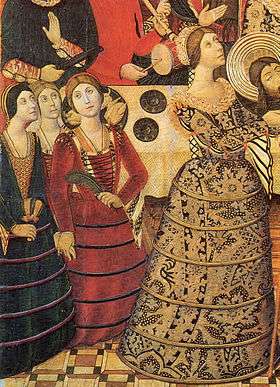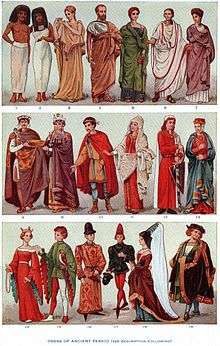Farthingale
A farthingale is one of several structures used under Western European women's clothing in the 16th and 17th centuries to support the skirts in the desired shape and enlarged the lower half of the body. It originated in Spain in the fifteenth century. Farthingales served important social and cultural functions for women in Renaissance Europe as they were used, primarily by court women, to show their high social position and wealth. This is because these structures increased the amount of expensive fabrics used in the gowns that covered them. [1]



Spanish farthingale
The Spanish verdugado, from which "farthingale" derives, was a hoop skirt originally stiffened with esparto grass; later designs in the temperate climate zone were stiffened with osiers (willow withies), rope, or (from about 1580) whalebone. The name verdugado comes from the Spanish verdugo ("green wood", or the more modern meaning of "executioner").
The earliest sources indicate that Joan of Portugal started to use verdugados with hoops in Spain. Joan had provoked much criticism as she allegedly wore dresses that displayed too much décolletage, and her wanton behaviour was considered scandalous. When she started to use farthingales, court fashion followed suit. As Joan had two illegitimate children by Pedro de Castilla y Fonseca, rumors abounded that she used the farthingale to cover up a pregnancy.
The earliest images of Spanish farthingales show hoops prominently displayed on the outer surfaces of skirts, although later they merely provided shape to the overskirt. Catherine of Aragon brought the fashion into England on her marriage to Arthur, Prince of Wales, in 1501. However, there is little evidence to show that she continued to wear this fashion as she adopted English styles of dress. One of the first references to a farthingale in England comes from the accounts of Princess Elizabeth in 1545 that described a farthingale made of crimson Bruges satin.[2]
Spanish farthingales were an essential element of Tudor fashion in England. The French educated Mary, Queen of Scots had a black taffeta "verdugalle" in 1550,[3] and a set of fashion dolls with 15 farthingales.[4] Farthingales remained a fixture of conservative Spanish court fashion into the early 17th century (as exemplified by Margaret of Austria), before evolving into the guardainfante of 17th-century Spanish dress.
French farthingale Roll

French farthingales originated in court circles in France and they first appeared in England during the 1570s. On 17 March 1577 the English ambassador to Paris, Amyas Paulet, sent a new type of farthingale to Queen Elizabeth I stating that it was “such as is now used by the French Queen and the Queen of Navarre.” Janet Arnold has stated that this new style was probably a roll that sat on top of the cone-shaped Spanish farthingale.[5]
Randle Cotgrave, in his Dictionarie of the French and English Tongues (1611), defined the French farthingale as “the kind of roll used by such women as weare no Vardingales.” Several wardrobe accounts and tailors' bills of the late 16th century give us an idea of what these rolls were made of: they were stuffed with cotton and rags, and stiffened with hoops of whalebone, wire or ropes made of bent reeds. Buckram (stiff canvas) is the most commonly mentioned material. Other references describe the rolls being starched.[6]
Here are a couple of sample references to rolls from Queen Elizabeth I's Wardrobe Accounts (MS Egerton 2806):
- “[for] making of thre rolles of hollande clothe with wyers bounde with reben (1585)
- making of a rolle of starched buckeram with whales bone (1586)
There are no extant examples of this style of undergarment, and only one illustration, a satirical Dutch engraving of c1600, that shows the bum-roll being affixed by a tiring-woman.[7] From contemporary references, and the visual cues provided by the engraving, it appears to have consisted of a bolster-like roll either stuffed or held out with reeds which, being fastened around the hips, served the purpose of widening the skirts at the hip area, creating drapes.
Some modern costumers conjecture that the French farthingale and the "great farthingale" were one and the same garment, the difference in shape and construction being due to changes in fashion from the 1580s to the 1590s.
French Wheel Farthingale or Great Farthingale
A second style of French farthingale, also known as the wheel, great, drum or cartwheel farthingale, became fashionable in England during the 1590s . It seems to have consisted of several hoops made from whalebone that graduated outwards from the level of the waistline in a wheel shape. This structure was often supported by a padded roll underneath, and was distinct in appearance from the other French farthingale roll, as it had a hard edge from which the skirts dramatically fell.[8]
Although there are also no surviving examples of this type of garment, there are a number of references to a "Great Farthingale" in Queen Elizabeth I's wardrobe accounts during the time when this style was in vogue. "Great" in this context referring to the large circumference of the farthingale which was required in order to achieve the fashionable silhouette.
The great farthingale appears to have been worn at an angle ("low before and high behind") which visually elongated the wearer's torso while shortening her legs. The angle was likely created by the use of bodies (corsets) or boned bodices with long centre fronts that pushed down on the farthingale, tilting it. Such an effect has been shown in many reconstructions of the garment. [9]
Some historians have raised doubts about the size of these garment, which some contemporaries claimed could be as wide as 1.4 metres. Instead they claim that the seemingly enormous size of these garments was an optical illusion created by wearing it with a pair of bodies (corset) that elongated and streamlined the torso. Criticisms of farthingales are also indicative of spatial anxieties relating to fears about these garments creating intimate personal spaces around the female body, masking the appropriation of social status, and physically displacing men. These fears continued into the eighteenth and nineteenth century, where tropes about the size of hoop petticoats (panniers) and crinolines continued.[10]
Farthingales for Queen Elizabeth were made by a specialist Robert Sibthorpe. Anne of Denmark had her gowns altered in 1603 to suit English fashions, and employed Robert Hughes to make farthingales from 1603 to 1618.[11] Large styles of French farthingale remained popular in England and France until the 1620s when they disappeared in portraiture and wardrobe accounts. They were replaced by small rolls or bum-rolls that persisted throughout the rest of the seventeenth century.[12] In Spain, the spanish farthingales evolved into the guardainfante and remained an identifiable part of Spanish dress until the eighteenth century.
Farthingale sleeves
In England, sleeves were enlarged and shaped with a whale bone armature, worn as a support underneath wide sleeves, and these were called "farthingale sleeves" or "vardingall sleeves." An account from William Jones for making a gown for Queen Elizabeth includes, "a payer of vardingall sleves of holland cloth bented with whals bone and covered with riben."[13] Another account from Jones, for the queen's dwarf Tomasen in 1597 includes a "paier of verthingale slevis of fustian." Jones made many pairs of farthingale sleeves in the 1580s, perhaps for the women of Elizabeth's court.[14]
See also
- 1500–1550 in fashion
- 1550–1600 in fashion
- 1600–1650 in fashion
- Hoop skirt
- Crinoline
Notes
- Bendall, Sarah A. (2019). "'Take measure of your wide and flaunting garments': The farthingale, gender and the consumption of space in Elizabethan and Jacobean England". Renaissance Studies. 33 (5): 712–737. doi:10.1111/rest.12537. ISSN 1477-4658.
- Bendall, Sarah A. (2019). "'Take measure of your wide and flaunting garments': The farthingale, gender and the consumption of space in Elizabethan and Jacobean England". Renaissance Studies. 33 (5): 712–737. doi:10.1111/rest.12537. ISSN 1477-4658.
- Marguerite Wood, Foreign Correspondence with Marie of Lorraine: Balcarres Papers, vol. 2 (Edinburgh, 1925), p. xxvii.
- Michael Pearce, Dolls of Mary Queen of Scots: Edinburgh Castle Research (Edinburgh, 2018), p. 18
- Arnold, Janet, 1932-1998 (1988). Queen Elizabeth's wardrobe unlock'd. Leeds [England]. ISBN 978-1-909662-53-7. OCLC 21912234.CS1 maint: multiple names: authors list (link)
- Queen Elizabeth's Wardrobe Accounts, MS Egerton 2806, lists the materials used for rolls made by the royal farthingale maker.
- Illustration, from Harold Koda, "Extreme Beauty: The Body Transformed, exhibition catalog (Metropolitan Museum of Art) 2001.
- Bendall, Sarah A. (2019-05-04). "The Case of the "French Vardinggale": A Methodological Approach to Reconstructing and Understanding Ephemeral Garments". Fashion Theory. 23 (3): 363–399. doi:10.1080/1362704X.2019.1603862. ISSN 1362-704X.
- Bendall, Sarah A. (2019-05-04). "The Case of the "French Vardinggale": A Methodological Approach to Reconstructing and Understanding Ephemeral Garments". Fashion Theory. 23 (3): 363–399. doi:10.1080/1362704X.2019.1603862. ISSN 1362-704X.
- Bendall, Sarah A. (2019). "'Take measure of your wide and flaunting garments': The farthingale, gender and the consumption of space in Elizabethan and Jacobean England". Renaissance Studies. 33 (5): 712–737. doi:10.1111/rest.12537. ISSN 1477-4658.
- Jemma Field, Anna of Denmark: Material and Visual Culture of the Stuart Courts (Manchester, 2020), pp. 124-9.
- Bendall, Sarah A. (2019). "'Take measure of your wide and flaunting garments': The farthingale, gender and the consumption of space in Elizabethan and Jacobean England". Renaissance Studies. 33 (5): 712–737. doi:10.1111/rest.12537. ISSN 1477-4658.
- HMC Salisbury Hatfield, vol. 14 (London, 1923), p. 47
- Janet Arnold, Queen Elizabeth's Wardrobe Unlock'd (Leeds, 1988), pp. 108, 146, 153.
References
- Anderson, Ruth Matilda: Hispanic Costume 1480–1530, The Hispanic Society of America, New York 1979. ISBN 0-87535-126-3
- Arnold, Janet: Patterns of Fashion: the cut and construction of clothes for men and women 1560–1620, Macmillan 1985. Revised edition 1986. ISBN 0-89676-083-9
- Arnold, Janet: Queen Elizabeth's Wardrobe Unlock'd, W S Maney and Son Ltd, Leeds 1988. ISBN 0-901286-20-6
- Bendall, Sarah: ‘Take measure of your wide and flaunting garments’: The farthingale, gender and the consumption of space in Elizabethan and Jacobean England. Renaissance Studies, 33 (2019): 712-737. doi:10.1111/rest.12537
- Bendall, Sarah: '"The Case of the “French Vardinggale": A Methodological Approach to Reconstructing and Understanding Ephemeral Garments', Fashion Theory, 23:3 (2019). 363-399. DOI: 10.1080/1362704X.2019.1603862
External links
| Wikimedia Commons has media related to Farthingales. |
- Elizabethan Costuming, incl. information about farthingales
- . Encyclopædia Britannica (11th ed.). 1911.
